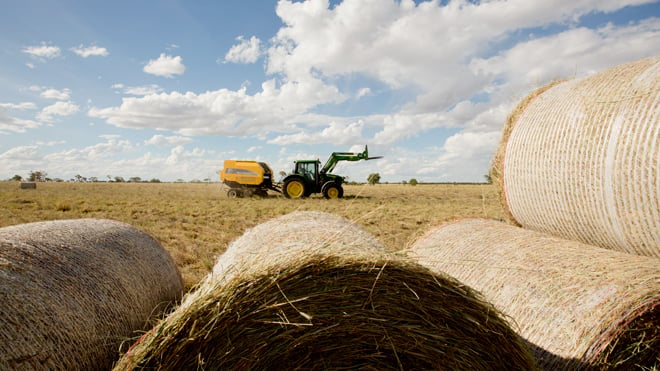Sampling methods for feed testing

With rainfall and temperatures fluctuating widely across Australia, feed testing is an invaluable step for livestock producers. With affordable lab services available nationwide, timely sampling and testing ensure producers make confident, data-driven feeding decisions to sheep health, productivity, and profitability, despite seasonal variability.
Authors: Steve Cotton, Dynamic Ag; Emily King, AWI National Extension Manager; and Krisi Frost, AWI Manager, Woolgrower Communications
The benefits of feed testing
Feed testing is a critical tool for optimising livestock nutrition, improving production efficiency, and ensuring economic sustainability. By analysing the nutritional composition of grain, forage, and fodder you can make informed feeding decisions, calculate feed rations, and budget for feed gaps to avoid over- or under-feeding.
As pastures mature quickly in warmer conditions, quality can drop sharply, making objective testing essential for assessing nutritional value.
If you are purchasing fodder from a supplier that has multiple lots or varieties of feed available, a feed test provides a very cost effective objective assessment of what feed is the cheapest on an energy and protein basis, and which will suit your sheep’s requirements.
There are multiple feed testing laboratories across Australia that provide essential nutritional information (as well as advanced reports containing the trace element composition of the feed combined with other parameters) that can help you understand the level of stock performance that could be achieved.
Before you start sampling
When collecting samples for feed analysis, it is important to obtain the most representative sample possible. As a starting point, speak to your laboratory and ask them if they have a preferred sampling method for the feed type you are testing. Most laboratories follow similar procedures and guidelines but there are some differences in sample collection procedures, often regarding the sample volume required.
The Australian Fodder Industry Association (AFIA) has published a set of guidelines and minimum standards relating to the sampling of hay and silage for feed analysis. The hay and silage sampling methods listed below are adapted from the AFIA Laboratory Methods Manual v8 September 2014 (pages 9–11).
Sampling procedure: pasture
To collect a pasture sample for quality analysis, follow the procedure below:
- Sample 15–20 areas across a paddock by taking a grab or ‘pluck’ sample.
- Samples should be collected from random areas of the paddock, but to reduce bias in where samples are collected, walk/ride/drive diagonally across the paddock and sample at similar intervals (e.g. about every 30 steps if you are walking) until you reach the other side of the paddock.
- If you get to the other side of paddock and your sample collection bag isn’t full, repeat the process travelling in the opposite diagonal direction.
- Samples should be collected down to grazing height to provide a representative sample.
- Do not include faeces, plant roots, or soil with your sample.
- Avoid sampling on stock camps and dung or urine patches.
Sampling procedure: grain
For grain samples taken from a silo or field bin:
- Fill a plastic bucket full of grain and take 5+ random handfuls from the bucket and place in the sample zip lock bag provided by the laboratory.
- Discard the remaining grain from the bucket, refill the bucket, and repeat the step above twice more until you have filled the sample bag to the specified line.
Sampling procedure: hay
Representative hay samples can only be obtained with a probe or core sampling device. Do not rely on a couple of handfuls or a ‘flake’ or ‘biscuit’ from one bale.
Australian made corers are commercially available, or a home-made corer can be made from 32 mm steel tubing. It should be at least 450 mm long with a slightly scalloped and sharp cutting edge.
Corers are driven using either a hand brace or by a continuously variable speed, electric drill (preferred option where practicable).
A portable generator is useful and can be justified if many samples are to be taken. Cordless drills can be used if they meet power (torque) requirements.
In the following sampling procedures, a ‘lot’ is defined as hay or silage taken from:
- the same species (pure or mixed) and variety;
- the same paddock or pit/bunker; and
- harvested within 48 hours.
A ‘lot’ of baled hay or cubes should not exceed 200 tonnes.
Hay sampling procedures vary depending on the bale size and method. Read on to choose the correct technique for your hay type:
- Small square bales
-
- Sample between 10–20 small square bales, selected at random from the lot.
- Take one core from each bale selected, probing near the centre of the ‘butt’ end and at right angles to the surface. Ensure that the corer does not get hot.
- Combine all cores into a single sample in a bucket and mix thoroughly. Keep the whole sample intact.
- Large round or square bales:
-
- Sample between 5–10 large bales, selected at random from the lot.
- Take one core from each side of all bales selected, probing at right angles to the surface at different heights.
- Combine all cores into a single sample in a bucket and mix thoroughly. Keep the whole sample intact.
- Cubes or pellets:
-
- Select a good handful of cubes or pellets from at least six (6) locations or bags which make up the complete lot.
- Combine the sub-samples in a bucket and mix thoroughly.
- Use the ‘riffle box’ or ‘coning and quartering’ process (see page 9–10 here for more information) to reduce sample size to at least 250 g, but not more than 500 g.
Sampling procedure: silage
Silage is best sampled at least three (3) weeks after it has been ensiled and as close to the time of feeding as is practicable.
Pit or bunker silage – unopened pit or bunker
- Obtain core samples for analysis using a long coring device that extends deeply into the pit or bunker. Sample from at least 3–5 locations to ensure a representative sample.
- Combine all the material into a single sample in a bucket and mix thoroughly. Keep the whole sample intact and do not subdivide.
Pit or bunker silage – opened pit or bunker
- Take random grab samples from at least 10 locations across a freshly cut face of the stack, although this will not provide as good a representative sample as multi-site coring.
- Combine all the material into a single sample in a bucket and mix thoroughly. Keep the whole sample intact and do not subdivide.
Wrapped baled silage
- Sample between 5–10 large bales at random using a coring device in the same manner as for large hay bales (see above).
- Combine all cores into a single sample in a bucket and mix thoroughly. Keep the whole sample intact.
Sending your sample to the lab
- Exclude as much air as possible from the feed test collection bag, then seal tightly.
- Whenever possible, collect and post the samples on the same day. If this is not possible, place your pasture sample in the fridge (NOT in the freezer) if not posted the same day as it was collected.
- Avoid collecting and sending sample(s) late in the week (e.g., Thursday or Friday) to avoid mail delays and the sample sitting in the heat over the weekend.
- It is best to collect and send samples on Monday to get them to the lab as quickly as possible. If samples are harvested late in the week, leave in the fridge over the weekend and send on Monday.












